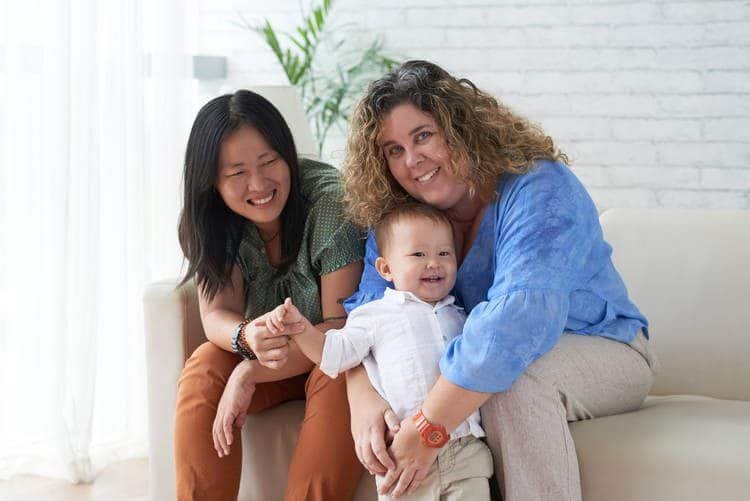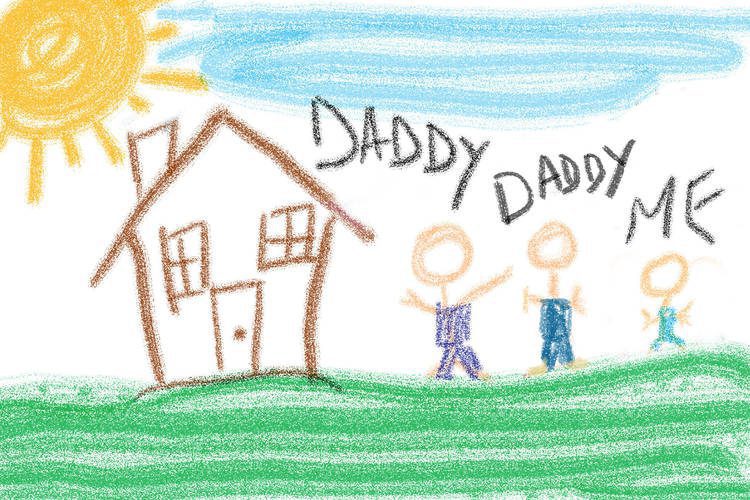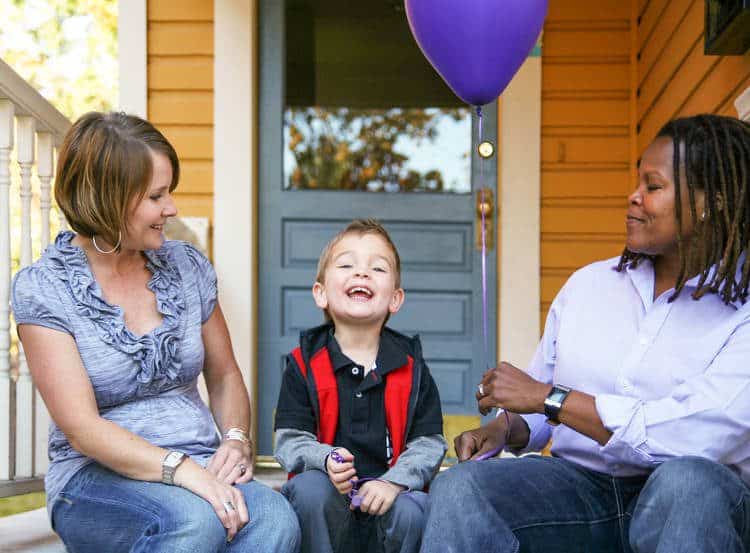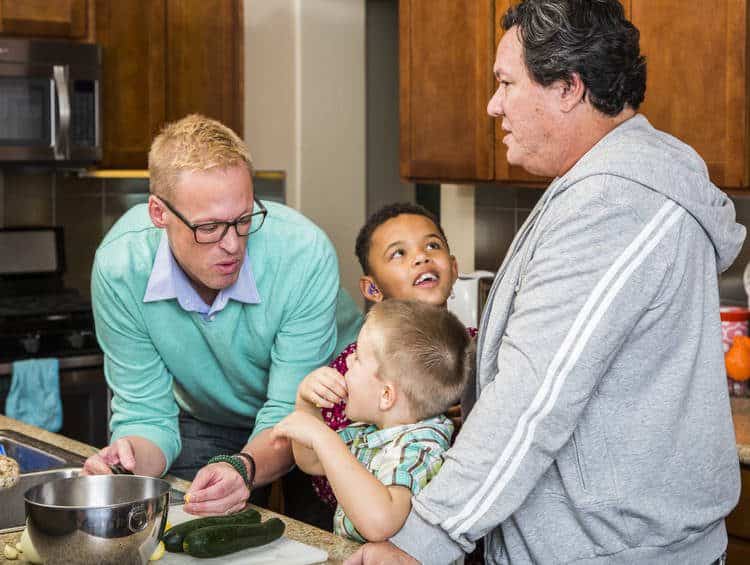Reihonna L. Frost and Abbie E. Goldberg, Clark University

Abstract
Early childhood education is a time when children and their parents are learning about their roles in a school. This makes early childhood education a crucial time for developing strong parent–school relationships with diverse families including LGBTQ parents, adoptive families, and multiracial families. This article gives specific, concrete suggestions about how to build and maintain a welcoming, representative, and inclusive environment for diverse families in schools.
As families in America become increasingly diverse, professionals working with children and families must expand their knowledge, practices, and policies in order to sensitively and effectively meet their needs. In particular, families with sexual minority parents, families built through adoption, and multiracial families have increased in prevalence. An estimated 3 million Lesbian, Gay, Bisexual, Transgender, and Queer (LGBTQ) adults in the United States have children (Gates, 2013); more than 2 million children in the United States are adopted and, of those children, approximately 25% have parents who are of different races than they are (Kreider & Lofquist, 2014). Further, many families can hold two or more of these identities (e.g., a two-mom transracially adoptive family). When considering ways to create an inclusive environment for families, it is important to consider their unique set of identities.
Elements of an Inclusive Environment
Creating a welcoming school or early childhood education (ECE) environment for all families is important because the climate of a program will impact parents’ sense of connection to the setting. Parents who are more connected to the program or school are more engaged in their child’s experience, which has positive implications for children’s academic functioning and social integration (Galindo & Sheldon, 2012). Further, parents’ early experiences with educational settings shape their understanding of and expectations for schooling throughout their child’s academic career (Galindo & Sheldon, 2012; Kosciw & Diaz, 2008). Therefore, early childhood educators are uniquely situated to help families integrate into early education communities and prepare to partner with their children for a lifetime of academic success.
Further, the degree to which parents and students feel accepted at a child’s school has consistently been linked to children’s sense of belonging at school, self-esteem, well-being, and mental health (Slaten, Ferguson, Allen, Brodrick, & Waters, 2016). Taken together, providing a welcoming, inclusive environment for children in their early education can impact their well-being and learning in the present and future.
Research with adoptive families of diverse sexual orientations and racial identities has identified the ways that ECE programs are and are not supportive. These broad areas of support fall into three domains: welcoming environment, representation of families like theirs, and meaningful inclusion of their families.
Welcoming Environment
Everyone wants to feel welcomed in the environments they spend time in. Parents and families feel welcomed when ECE programs, personnel, and other parents communicate appreciation for their presence and enthusiasm about supporting them and their needs.
Example: One lesbian adoptive mother described feeling welcomed by her child’s ECE based on the ECE’s response to her explaining their family situation, “The counselor said it was becoming more common, which was the perfect thing to say.” Here, the counselor communicated comfort with their family structure and willingness to support the family’s needs (Goldberg, Black, Sweeney, & Moyer, 2017).

Same-sex parents report that they prioritize LGBTQ-friendliness when selecting preschools. Photo: Dragon Images/shutterstock
Representation
Seeing one’s family reflected in a child’s ECE program is important for families and children. This includes families like theirs being referred to in classroom language, materials, and curriculum, and seeing their identities mirrored in staff members and other parents.
Example: Several families described ways that their family was represented in the classroom activities and materials. One family that had adopted a child from China described how the ECE was inclusive of their child’s culture like this: “We have felt very accepted and it is very inclusive in general. The teacher incorporated Chinese New Year activities and books” (Goldberg, 2014). In addition, several LGBTQ parents described activities around LGBT Pride month that included coloring rainbow flags while talking about “the history and importance of the rainbow flag” (Goldberg, Black et al., 2017).
Meaningful Inclusion
Beyond just feeling welcomed, diverse families thrive when they have opportunities to engage with a program in a substantive way. This can include having events in the school that are truly applicable for their families and being encouraged to participate in parenting groups and activities.
Example: A lesbian adoptive mother recounted a time that her daughter’s teacher seamlessly incorporated her daughter’s adoptive experience into circle time. “When another student … said that he celebrates his adoption day, and the teacher said, ‘Does anybody else celebrate that?’ and [daughter] raised her hand, and the teacher said ‘Would you like to explain it, or do you want your mom to explain it?’ and [daughter] said ‘Neither.’ ” Here, the daughter was given an opportunity to be meaningfully involved in sharing her experience, but she was also allowed to decide not to, depending on her comfort level (Goldberg, Black et al., 2017).
Keeping these three domains in mind, we will now use research to explore the needs of LGBTQ, adoptive, and multiracial families in early childhood settings. Specifically, when discussing ECE, parents identify needs at three main levels: the administrative level, the classroom level, and the community level. The following sections will explore how schools can improve to be more welcoming, inclusive, and diverse at each level of the school system.
Administrative Level
The administrative level refers to the ways schools or programs are organized and operated outside of the specific classroom. These areas can include advertising and admissions procedures, enrollment and classroom assignments, and communications.
Same-sex parents have reported that they prioritize LGBTQ-friendliness when selecting preschools (Goldberg & Smith, 2014). They assess LGBTQ-friendliness of a school using a variety of factors including the school’s reputation in the community and the ways that school personnel respond to them during tours or visits (Goldberg, 2014; Kosciw & Diaz, 2008). Similarly, multiracial families have reported seeking out schools that actively and positively welcome racial minorities (Goldberg, 2014; Goldberg & Smith, 2014). Prospective student tours and interviews communicate important information to parents. Some parents find school administrators warm and enthusiastic about hearing about a specific family’s structure while others find that administrators seem awkward, dismissive, or uncomfortable. Parents report feeling welcome when administrators engaged their questions openly and demonstrated an understanding of the parents’ concerns, even when their answers were less than ideal (e.g., when acknowledging that the school did not have other families similar to this one; Goldberg, Allen, Black, Frost & Manley, 2018). When parents feel welcome, they are more likely to attend and also to feel good about attending a particular school or program.

Providing a welcoming, inclusive environment for children in their early education program can impact their well-being and learning in the present and future. Photo: Matthew Jacques/shutterstock
How well diversity in family structure is represented at an administrative level is also important to parents. For instance, parents endorse feeling more comfortable with a potential school if the school staff shares some of the identities of their families (e.g., if the heads of the school are LGBT or adoptive parents; Goldberg, 2014). Further, lesbian and gay parents appreciate when the school paperwork allows them to accurately represent their families–for example, by allowing room for “Parent 1” and “Parent 2” as opposed to asking for information about “Mom” and “Dad,” which suggests an assumption that all parents match this configuration (Goldberg, 2014). Parents appreciate when schools welcome and encourage their participation in school life. For instance, lesbian and gay parents have reported feeling meaningfully included when their feedback on problematic forms is responded to in a positive and responsive manner (e.g., changing Mom and Dad to Parent 1 and Parent 2).
Questions for Programs to Consider
Welcoming environment.
- What types of families are you looking to recruit? How can you reach out to diverse families in your recruitment? How can you communicate inclusiveness on your websites, brochures, and signage?
- Are staff members prepared to be warm and welcoming to all types of families? Can you provide training to ensure that staff members respond to diverse families in affirming, welcoming ways? What language do staff members use when talking to and referring to parents and families?
Representation of families.
- Are your administrators, teachers, and other parents diverse? Is your school actively working to diversify the types of social identities and family structures that are represented?
- Is the paperwork for your school flexible enough to include many types of families? What changes can you make to allow more families to represent themselves accurately?
Meaningful inclusion.
- Are all new parents approached for roles on a parent board? How are people selected? Consider how you can engage non-traditional families without tokenizing them as the “multiracial/adoptive/gay parent.”
Case Example: Lisa, who is White, and her wife, Liz, who is Latina, adopted their African American daughter, Tia, from foster care. When they are enrolling in the early childhood program they’ve chosen, they are pleased to see that the intake forms have lines for “Parent 1” and “Parent 2.” However, the forms have only one place for Race/Ethnicity, assuming that all members of the whole family are the same race. When they asked what to do, the administrative assistant became confused and suggested that “it doesn’t really matter.” Later, when they are on the tour, Liz asks about the diversity of the families at the school. The tour guide is quick to share that they have several lesbian-parented families at the school. When Liz asks specifically about racial diversity and adoption status, the tour guide is less sure. He says, “Um…I’m sure we do have some. Yeah. We must.” Questions to consider: What went well in this intake process? In what ways was the school welcoming and representative? What were the problems? How could this be addressed?
Classroom Level
The classroom level refers to the interactions that occur between teachers and children, as well as those between children. This level includes curriculum choices, the types of materials and activities in the classroom, and the ways that families are discussed and represented.
It is encouraging that the majority of parents in adoptive, multiracial, and LGBT-parented diverse family configurations have reported that they feel welcomed in their ECE setting and have faced limited amounts of overt discrimination or exclusion (Goldberg, Black et al., 2017; Kosciw & Diaz, 2008). Still, among those parents who experienced overt discrimination, a range of experiences are described, from implicit microaggressions to explicit exclusion from activities and groups. For example, teachers’ confusion around or unwillingness to use the names for each parent. Some parents described teachers who seemed to be genuinely confused that one dad was “Dad” and one was “Papa” or that they really struggled to get these names right. Other parents described teachers just not trying or not being willing to use the names used for each parent in same-sex couples or referring to a child’s birth mother as their “real mother” in adoptive families (Goldberg, 2014). Others described explicit discrimination (e.g., refusing to post a child’s homework in the classroom because it was about a queer couple; Kosciw & Diaz, 2008). Identifying the risks for these types of overt transgressions and addressing them quickly, effectively, and with sensitivity is a crucial job for schools seeking to support diverse families in ECE.
Considerations that parents have reported as prominent in their ECE decision making include concerns around how families are represented in the activities and materials and in the classroom. Research has shown that families look for their children’s classrooms and the classroom activities and materials to reflect their family (Goldberg, 2014; Goldberg & Smith, 2014; Kosciw & Diaz, 2008). For example, LGBTQ families and adoptive and multiracial families indicated that they expect their child’s classrooms to contain books with characters that match (at least some) of their child’s identities and have been known to buy these materials for a classroom if they are missing (Goldberg, 2014; Goldberg, Black et al., 2017). Further, families expected schools to incorporate information about a diverse array of family forms, including the ones that match their families. This is particularly relevant when the focus of the activity is about families and about children’s early histories. For instance, LGBTQ parents described being disappointed by teachers only referring to heterosexual parented families (Goldberg, 2014; Goldberg, Black et al., 2017). Beyond what is taught, families reported differing levels of sensitivity in the ways that teachers create assignments and in-class activities. For example, adoptive families struggled to complete “family tree” assignments and other activities that depict families in a structured way because of their complicated family-building process and relationships with the birth family. Parents described particularly appreciating when teachers have reached out to families to provide an alternative assignment or have carefully framed the assignments to allow multiple interpretations. Further, parents regularly described discomfort around classroom activities like “Donuts With Dads” and “Bring Mommy to Class,” which often do not apply to their families (Goldberg, Black et al., 2017). Alternatives to these activities include having gender-neutral days like “Parents’ Day” or “Special Elders’ Day.” Other times, ECE programs can reach out to parents in advance of planned celebrations like Mother’s Day or Father’s Day and ask who the family would like to honor. Often, families are excited to honor a birth family member or an extended family member of importance, or they may have their own traditions for the holidays (Welcoming Schools, 2018).

When parents feel welcome, they are more likely to attend and also to feel good about attending a particular school or program. Photo: Annette Shaff/shutterstock
Questions for Programs to Consider
Welcoming environment.
- Are all staff members open, affirming, and trained in diversity issues? Is diversity conceptualized in meaningful, specific ways including thinking about families with multiple minority identities and differing family configurations?
Representation of families.
- Are different types of families represented in materials?
- LGBTQ
- Adoptive
- Multiracial
- Is the classroom made up of diverse staff?
Meaningful inclusion.
- Do assignments account for differences among families?
- Are activities organized in the classroom applicable to all families? Do special “accommodations” need to be made? Do parents need to reach out to ask for an accommodation? Did teachers plan for this and make the activity inclusive?
- Can the structures for parents’ participation work for all families?
Example: Joe and Carissa are a White heterosexual couple who adopted their White 3-year-old son, Jacob, through foster care. Jacob was 2 years old when he joined the family. Jacob’s teacher sent home an assignment asking Jacob to bring in a picture from the day he was born, from when he was 1-year-old, and from when he was 2-years old. Jacob’s parents do not have photos from those years of his life and cannot complete the assignment. Even though Jacob’s teacher knows that he is adopted, he did not include an adapted assignment for him. This creates unnecessary stress for Jacob’s parents and potentially prompts difficult conversations with Jacob around his adoption-related loss. What could Jacob’s teacher have done differently to be inclusive of Jacob’s family? How should Jacob’s parents address their concerns?
Community Level
The community level refers to the interactions that occur between members of the school community in and outside of the classroom. This level includes interactions between parents at the school and interactions at school community events like fundraisers or family gatherings.
LGBTQ, adoptive, and multiracial families particularly emphasized the ways that their minority statuses make it difficult to join the school community in ECE settings. Specifically, parents described the difficulty of being the first and/or only family like theirs in a school and the ways that this limits their ability to befriend other parents and to join in on parenting activities (Goldberg, 2014; Goldberg, Frost, Manley, & Black, 2017; Kosciw & Diaz, 2008). At the same time, parents emphasized that they were not always sure which parents from their children’s schools would be welcoming to a family like theirs. While program administrators cannot be expected to manage social interactions among parents, these specific concerns help to emphasize the importance of building a diverse school community that provides safe, supportive environments in which to connect.

LGBTQ, adoptive, and multiracial families particularly emphasized the ways that their minority statuses make it difficult to join the school community in early childhood education settings. Photo: CREATISTA/shutterstock
Questions for programs to consider:
Welcoming environment.
- Is there a welcoming environment among parents?
- Does your school have procedures for encouraging inclusion and discouraging exclusion of parents based on identities?
Representation.
- Are there diverse families in the community?
- Do you have families who are the only family like them? How can you reach out to them and help them connect?
Meaningful inclusion.
- Are events organized in ways that are accessible and comfortable for different types of families? Are all genders welcome to participate? What assumptions or stereotypes about the parents or guardians might your program be inadvertently promoting?
Example: Zach and Sam are a White gay couple who adopted their daughter, Jessica, through private domestic adoption. Jessica’s new early childhood center is having a “Craft Night” for parents to meet each other. Zach attends the event while Sam is home with Jessica. When Zach arrives, he is the only man at the event. The supplies are for making necklaces and there is a wide selection of charms that say “Mom.” Without any “Dad” charms, Zach decides to make a “Mom” necklace for Jessica’s birth mother. Throughout the event the moms talk to each other, but no one seems to be interested in Zach. When a woman does come over to introduce herself she says, “We’ve never had a man at this event before! Is your wife sick or something?” What could be different about this event that would make it more welcoming and inclusive? What factors made this situation difficult?
Conclusion
ECE professionals have an opportunity to engage with an increasingly diverse population of parents and families. How they do this can fundamentally shape how parents and families will interact with schools throughout the child’s academic career. This means that early childhood educators should work diligently to build programs that are welcoming and inclusive for all family types. In this article we outlined the ways that professionals can focus on developing an inclusive environment at multiple levels within their school settings. We further gave guidelines around thinking beyond being welcoming to encourage professionals to think about how different types of families are and are not represented in their policies, staff, and curriculum and how programs can be built to meaningfully include families of all kinds. Taken together, it is clear that there are many ways for school administrators to develop and maintain a school that is welcoming and inclusive for diverse families. While parents in current research identified a variety of challenges in these areas, they were also quick to enumerate successes that should encourage administrators to strive to expand these gains.
Successful Example: Stacey and Janell are an African American lesbian couple who adopted their African American son, Alex, from foster care. Alex is 3 years old and has attended an ECE program for the past 6 months. The staff have noticed that children in the class have been playing frequently in the playhouse corner and that disagreements have come up around which people can be “in a family.” The staff asked all families to send in pictures and notes about who the people in their family are and some things they do with their family. Stacey and Janell appreciated how open the assignment was and enjoyed working with Alex to identify who their family members were. They included a picture of Stacey, Janell, and Alex together and also included a picture of Alex’s birth grandmother from his birthday party. Alex also asked to draw a picture of his birth brother who lives far away. Stacey and Janell were nervous that the ECE staff would not understand their family structure and asked to speak with staff about the activity. To their delight, the staff were excited to discuss the material with them. The staff asked for clarification around how to best talk about the birth brother and birth grandmother and demonstrated that they remembered that Alex called Stacey “Mommy” and Janell “Mama.” Further, the staff offered that Stacey or Janell could come to class on the day of the activity if they wanted to participate in the discussion and expressed enthusiasm for what they could contribute. Janell agreed to take a few hours off of work that morning to have a fun conversation about families with Alex’s class. How did the ECE staff demonstrate a welcoming attitude toward different types of families? How did this activity allow for different family configurations to be represented? How did ECE staff provide opportunities for meaningful inclusion?
Learn More
For further information and more ideas about how to support diverse types of families in early childhood education, consider these resources:
- Checklist for a Welcoming and Inclusive School Environment
- Resources for an LGBTQ and Gender Inclusive School
Early Childhood Education Assembly
Harvard Graduate School of Education
Or check out this helpful book:
From the Dress-Up Corner to the Senior Prom: Navigating Gender and Sexuality Diversity in Prek-12 Schools
J. Bryan (2012)
Plymouth, UK: R&L Education.
Authors
Reihonna L. Frost, MA, is a doctoral student in clinical psychology at Clark University. Her research interests are united by the basic question, “What works in adoption?” She is curious about what it means to be an adoptive family and how adoption experiences differ for diverse families. She is also interested in child development within the context of the adoptive family. She is particularly interested in questions around adoptive siblinghood and sibling groups in foster care and adoption. She has co-authored several papers on diverse adoptive families and their experiences with friends, family, communities, and schools. Her master’s thesis focused on the second transition to parenthood for adoptive families.
Abbie E. Goldberg, PhD, is a professor of clinical psychology at Clark University. Her research focuses on diverse individuals and families, with attention to their experiences in various social contexts (e.g., schools, communities, the legal system). For more than a decade, she has been conducting a longitudinal study of adoptive parenthood among lesbian, gay, and heterosexual couples. She is also currently conducting research on transgender students’ experiences in higher education. She is the author of more than 100 peer-reviewed articles and two books, and the editor of three books. She has received funding from the National Institutes of Health, the Spencer Foundation, the Williams Institute, and other sources.
Suggested Citation
Frost, R. L., & Goldberg, A. E. (2019). The ABCs of diversity and inclusion: Developing an inclusive environment for diverse families in early childhood education. ZERO TO THREE Journal, 39(3), 36–41.
References
Galindo, C., & Sheldon, S. (2012). School and home connections and children’s kindergarten achievement gains: The mediating role of family involvement. Early Childhood Research Quarterly, 12, 90–103.
Gates, G. (2013). LGBT parenting in the United States. Source
Goldberg, A. E. (2014). Lesbian, gay, and heterosexual adoptive parents’ experiences in preschool environments. Early Childhood Research Quarterly, 29, 669–681.
Goldberg, A. E., Allen, K. R., Black, K., Frost, R. L., & Manley, M. (2018). “There is no perfect school…”: The complexity of school decision-making among lesbian and gay adoptive parents. Journal of Marriage & Family. 80(3), 684–703. doi:10.1111/jomf.12478
Goldberg, A. E., Black, K., Sweeney, K., & Moyer, A. (2017). Lesbian, gay, and heterosexual adoptive parents’ perceptions of inclusivity and receptiveness in early childhood education settings. Journal of Research in Childhood Education, 31, 141–159.
Goldberg, A. E., Frost, R., Manley, M., & Black, K. (2017). Meeting other moms: Lesbian adoptive mothers’ relationships with other parents at school and beyond. Journal of Lesbian Studies, 22(1), 67–84.
Goldberg, A. E., & Smith, J. Z. (2014). Preschool selection considerations and experiences of school mistreatment among lesbian, gay, and heterosexual adoptive parents. Early Childhood Research Quarterly, 29, 64–75.
Kosciw, J. G., & Diaz, E. M. (2008). Involved, invisible, ignored: The experiences of lesbian, gay, bisexual, and transgender parents and their children in our nation’s K-12 schools. New York, NY: Gay, Lesbian, Straight Education Network.
Kreider, R. M., & Lofquist, D. A. (2014). Adopted children and stepchildren: 2010, Current Population Reports, P20–572. Washington, DC: U.S. Census Bureau.
Slaten, C. D., Ferguson, J. K., Allen, K. A., Brodrick, D. V., & Waters, L. (2016). School belonging: A review of the history, current trends, and future directions. The Educational and Developmental Psychologist, 33(1), 1–15.
Welcoming Schools. (2018). Diverse families on Mother’s Day and Father’s Day. Source


